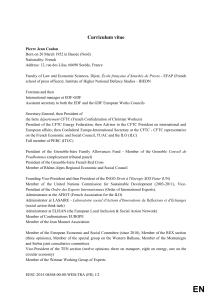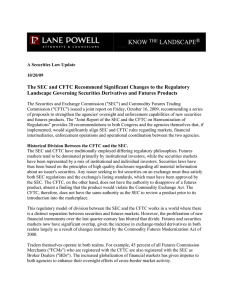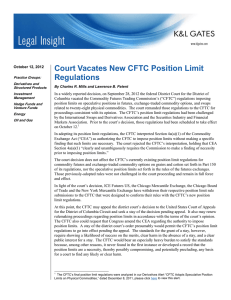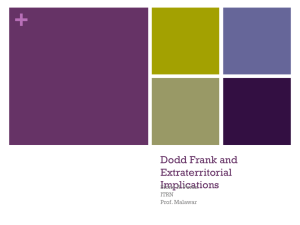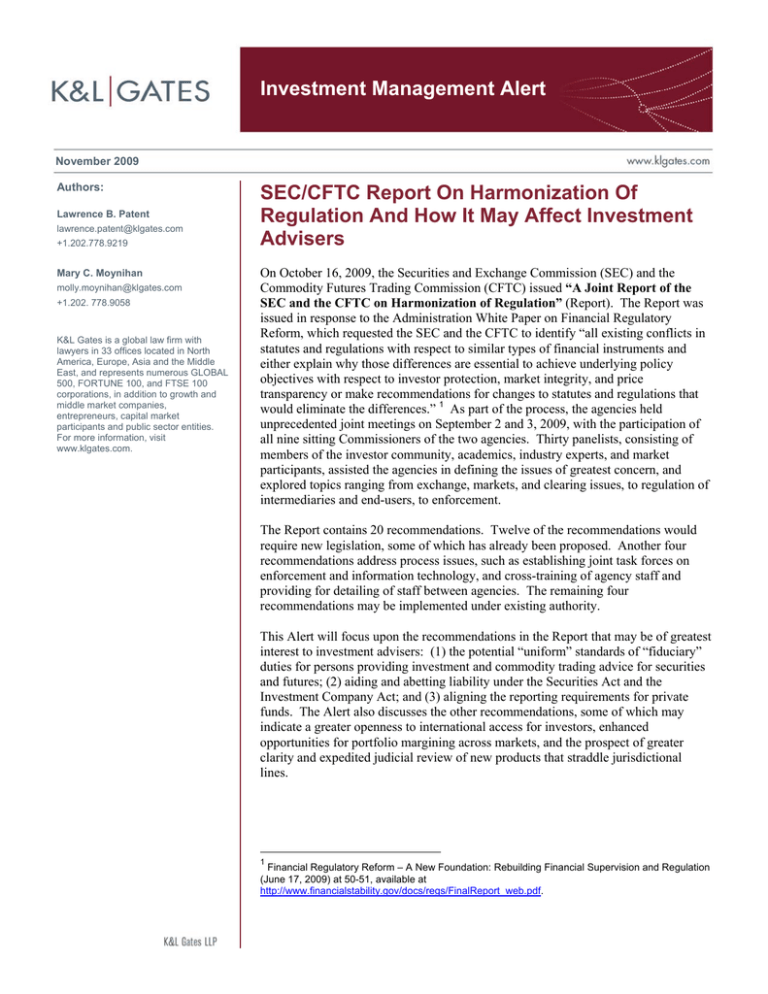
Investment Management Alert
November 2009
Authors:
Lawrence B. Patent
lawrence.patent@klgates.com
+1.202.778.9219
Mary C. Moynihan
molly.moynihan@klgates.com
+1.202. 778.9058
K&L Gates is a global law firm with
lawyers in 33 offices located in North
America, Europe, Asia and the Middle
East, and represents numerous GLOBAL
500, FORTUNE 100, and FTSE 100
corporations, in addition to growth and
middle market companies,
entrepreneurs, capital market
participants and public sector entities.
For more information, visit
www.klgates.com.
SEC/CFTC Report On Harmonization Of
Regulation And How It May Affect Investment
Advisers
On October 16, 2009, the Securities and Exchange Commission (SEC) and the
Commodity Futures Trading Commission (CFTC) issued “A Joint Report of the
SEC and the CFTC on Harmonization of Regulation” (Report). The Report was
issued in response to the Administration White Paper on Financial Regulatory
Reform, which requested the SEC and the CFTC to identify “all existing conflicts in
statutes and regulations with respect to similar types of financial instruments and
either explain why those differences are essential to achieve underlying policy
objectives with respect to investor protection, market integrity, and price
transparency or make recommendations for changes to statutes and regulations that
would eliminate the differences.” 1 As part of the process, the agencies held
unprecedented joint meetings on September 2 and 3, 2009, with the participation of
all nine sitting Commissioners of the two agencies. Thirty panelists, consisting of
members of the investor community, academics, industry experts, and market
participants, assisted the agencies in defining the issues of greatest concern, and
explored topics ranging from exchange, markets, and clearing issues, to regulation of
intermediaries and end-users, to enforcement.
The Report contains 20 recommendations. Twelve of the recommendations would
require new legislation, some of which has already been proposed. Another four
recommendations address process issues, such as establishing joint task forces on
enforcement and information technology, and cross-training of agency staff and
providing for detailing of staff between agencies. The remaining four
recommendations may be implemented under existing authority.
This Alert will focus upon the recommendations in the Report that may be of greatest
interest to investment advisers: (1) the potential “uniform” standards of “fiduciary”
duties for persons providing investment and commodity trading advice for securities
and futures; (2) aiding and abetting liability under the Securities Act and the
Investment Company Act; and (3) aligning the reporting requirements for private
funds. The Alert also discusses the other recommendations, some of which may
indicate a greater openness to international access for investors, enhanced
opportunities for portfolio margining across markets, and the prospect of greater
clarity and expedited judicial review of new products that straddle jurisdictional
lines.
1
Financial Regulatory Reform – A New Foundation: Rebuilding Financial Supervision and Regulation
(June 17, 2009) at 50-51, available at
http://www.financialstability.gov/docs/regs/FinalReport_web.pdf.
Investment Management Alert
Investment And Commodity Trading
Advisory Services
The sixth recommendation in the Report states that
there should be “legislation that would impose a
uniform fiduciary duty on intermediaries who
provide similar investment advisory services
regarding futures or securities.” 2 The agencies
recommend that a consistent standard apply to
commodity trading advisors (CTAs), futures
commission merchants (FCM), commodity
introducing brokers (IBs), broker-dealers (BDs), or
investment advisers (IAs) that provide similar
personalized investment and commodity trading
advisory services. The Report does not limit this
recommendation to registered entities, so
presumably commodity pool operators (CPOs) that
are exempt from registration as a CTA because they
only advise pools that they operate also would be
subject to the new fiduciary standard. However, it
does not appear that the recommendations seek to
apply fiduciary duty standards to CTAs and IAs that
provide only non-personalized advice.3
Currently, as the Report points out, neither the
Commodity Exchange Act (CEA) nor the CFTC’s
regulations explicitly establish “fiduciary”
obligations. The Report states that IAs are
considered fiduciaries under the SEC’s regulatory
regime, but the Report also notes that various court
cases recognize that the extent to which BDs, CTAs,
CPOs and FCMs may have fiduciary duties can vary
under state common law that will turn on specific
factual circumstances.
There have been attempts in the past to extend
certain regulatory requirements applicable to CTAs,
such as providing disclosure documents to
prospective clients, to FCMs that operate in-house
managed futures account programs. These efforts
have been abandoned in response to FCM arguments
that these additional requirements are unnecessary
because FCMs are required to meet minimum
financial requirements that are not applicable to
2
Report at 90.
Advisers that provide only non-personalized advice are not
considered to be fiduciaries. See Lowe v. SEC, 472 U.S. 181
(1985); see also CFTC Regulation 4.14(a)(9) (exempting such
advisers from registration under the CEA). However, these
advisers would still be subject to general antifraud
proscriptions and restrictions on advertising.
3
CTAs, and because FCMs tend to have more
sophisticated and highly structured supervisory
procedures than CTAs. FCMs can be expected to
make similar arguments against any new duties
being imposed upon them, and it will be interesting
to see if such arguments are convincing enough to
legislators to sustain the current standards.
Aiding And Abetting Liability
Another recommendation for legislative action is to
add specific statutory proscriptions against aiding
and abetting violations of the Securities Act and the
Investment Company Act, which would expand
SEC enforcement authority to prosecute persons for
aiding and abetting such violations. The CEA
already contains specific proscriptions against
aiding and abetting any violations of that statute and
CFTC regulations.
Reporting And Recordkeeping
Requirements
One recommendation of the Report that would not
require new legislative authority is the
recommendation to align specific private fund
reporting and recordkeeping requirements. The
Report states that the CFTC and the SEC should
review regulatory requirements applicable to IAs
and CTAs/CPOs with respect to private funds to
eliminate, as appropriate, any inconsistent or
conflicting provisions regarding: (i) the use of
performance track records; (ii) requirements
applicable to investor reports (including the
financial statements often used by registered IAs to
comply with the Advisers Act custody rule and the
financial statements delivered to investors by
CPOs); and (iii) recordkeeping requirements.
Because the agencies would not have to wait for
legislative action to implement this
recommendation, any necessary amendments to
harmonize regulations could proceed on the
agencies’ own schedules. As far as recordkeeping
requirements are concerned, the Report separately
calls for harmonization of all recordkeeping
requirements between the CFTC and SEC. The
Advisers Act Rule 204-2 generally specifies a fiveyear retention period, the first two in the office of an
adviser. The CFTC recordkeeping retention
regulation requires five-year retention for all
records, and CPOs and CTAs must maintain records
in their main office. It would appear that these
November 2009 2
Investment Management Alert
provisions can be easily harmonized. The Report
did not address requirements for publicly traded
funds.
International Trading
Regulatory standards applicable to international
trading is another area where no new legislation
would be needed to implement the agencies’
harmonization objectives. The Report recommends
that the SEC review its approach to cross-border
access to determine whether greater efficiencies
could be achieved for cross-border securities
transactions consistent with investor protection and
the public interest. The Report notes that the CFTC
has provided greater openness for U.S.-located
persons to trade on non-U.S. markets and through
non-U.S. intermediaries, under a number of
exemptions provided in accordance with Part 30 of
the CFTC’s regulations, than the SEC has permitted
for U.S.-located securities investors.
The CFTC Part 30 regulations have been in place for
over 20 years and the CFTC has found few, if any,
customer protection issues concerning transactions
on non-U.S. futures markets by U.S.-located
customers. The SEC may be able to benefit from the
CFTC’s experience in the international arena in
order to establish a model similar to the CFTC’s Part
30 regulations. The Report indicates that the SEC
could consider limited revisions to SEC Rule 15a-6,
which governs the interaction of U.S. investors with
foreign broker-dealers. Industry participants have
suggested that the SEC could also reconsider its
stance on products traded on non-U.S. markets,
particularly security futures products. The SEC only
recently, and after some prodding from Congress,
permitted limited trading in security futures products
outside the U.S. by “qualified institutional buyers”
and non-U.S. persons, as explained in an earlier
Alert. Nonetheless, the idea of mutual recognition
has engendered considerable opposition, and
Chairman Schapiro has signalled that she will move
slowly, if at all, in this area.
The Report goes in the other direction, however,
when it recommends legislation to empower the
CFTC to require foreign boards of trade (FBOT) to
register with the CFTC. This recommendation is
consistent with provisions in Title VII of the
Administration’s proposed financial regulatory
reform legislation. The CFTC has had in place for
over a decade a “no-action” procedure whereby
members of FBOTs located in the U.S. can have
direct access to the FBOT’s trading facility to trade
on their own behalf. This again has proven to be an
area free of investor complaints. In recent years,
some of the no-action relief has also permitted
FBOT member CPOs and CTAs to trade on behalf
of commodity pools or managed accounts, under
certain conditions. The CFTC has considered
adopting regulations in this area, but has refrained
from doing so and maintained the no-action process
because of some difficult definitional issues and a
concern about the measures international regulators
might be prompted to take regarding the rights of
U.S. exchanges to offer access to their trading
facilities from within their countries, if the U.S.
required licensing of FBOTs. The current CFTC
approach of cross-border recognition and
denomination of a lead international regulator for
each FBOT, with appropriate information sharing
arrangements and processes for customer redress,
has worked well to date and could serve as a general
model across the globe and among all financial
markets.
Portfolio Margining
There was a great deal of discussion at the
September meetings about portfolio margining, a
process whereby customer margin requirements
would be based upon a risk assessment across the
customer’s entire portfolio of futures and securities
products. Where customers hold related positions
across markets that are risk reducing when
examined together, margin requirements could be
reduced appropriately and capital could be freed up
for other uses. The CFTC and SEC would support
legislation that confers upon customers the choice
of portfolio margining in a single futures or
securities account at a dually registered BD/FCM,
which is similar to the way security futures are
handled now, provided the firm offers customers a
choice of type of account. Specifically, the
Commissions would support legislation that: (i)
clarifies that security options, security futures
products (SFPs), and certain other securities
derivatives may be held in a futures account and
that, in the event of the firm’s insolvency, customer
claims would not be protected under the Securities
Investor Protection Act (SIPA), but would be
resolved under the futures insolvency regime; (ii)
clarifies that futures may be held in securities
November 2009 3
Investment Management Alert
portfolio margin accounts and that the CFTC may
waive its segregation requirements with respect to
such futures; and (iii) extends SIPA protection to
customer claims based on any futures and options on
futures (and certain other securities-based
derivatives) held in a securities portfolio margin
account, together with the collateral held to margin
those positions. Such an approach may increase
SIPC premiums charged to dually registered firms,
which may be passed on to customers, but this could
provide customers with greater choice than is now
the case regarding how their positions and funds are
held and treated in a bankruptcy.
The Commissions acknowledge that industry
participants are currently developing different
approaches to achieving the benefits of portfolio
margining, including the two account (“two pot”)
model. The Report recommends that the CFTC and
SEC should undertake to review their existing
customer protection, margin and other relevant
regulations to determine whether any changes or
exemptive relief would be necessary to achieve the
full benefits of risk-based portfolio margining. The
Report further recommends that the Commissions
undertake, with input from experts, the industry, and
the public, to study whether further modifications to
portfolio margining, including adoption of a one
account (“one pot”) model that would accommodate
all financial instruments and all BDs and FCMs,
would be in the public interest.
Novel New Products
The Report recommends that Congress enact
legislation that would provide a process for
expedited judicial review of jurisdictional disputes
between the agencies regarding new products. In a
Memorandum of Understanding (MOU) between the
CFTC and SEC dated March 11, 2008, the
Commissions “acknowledge that there may be
instances in which novel derivative products may
reflect elements of both securities and commodity
futures or options.” Accordingly, the SEC and the
CFTC support legislation that is designed to create:
(i) greater legal certainty with respect to product
listings and the agencies’ use of exemptive
authority; and (ii) a review process for jurisdictional
disputes that includes a firm timeline.
Specifically, the SEC and CFTC would support
legislation that permits: (i) the CFTC to exercise
jurisdiction over an instrument that the SEC
exempts, conditionally or unconditionally, pursuant
to its authority under the Securities Exchange Act;
and (ii) the SEC to exercise jurisdiction over a
securities-related instrument that the CFTC has
exempted pursuant to its authority under the CEA.
The CFTC and the SEC would support legislation
that establishes a time-frame and process along the
following lines: (a) if either agency receives an
application for listing of a novel derivative product
that may have elements of both securities and
commodity futures or options, agency staff shall
immediately notify the other agency’s Secretary and
forward a copy of such application; (b) upon a
request by the Chairman or Commission of either
agency, the other agency’s Commission shall,
within 120 days of such request, by order determine
whether the Commission intends to assert
jurisdiction; and (c) if one agency does not agree
with the other agency’s determination regarding the
status of a product, it may petition a U.S. Court of
Appeals for expedited review.
A new spirit of cooperation between the CFTC and
SEC reflected in the Report might suggest a lesser
likelihood of jurisdictional squabbles between the
agencies. However, there will undoubtedly be close
cases in the future, as the 2008 MOU recognized. It
must also be kept in mind that the agencies are not
the sole stakeholders in such cases. The tough cases
will be presented by parties that are seeking to bring
innovative, profitable products to market, who may
have their own interests and preferences for where
and how trading takes place. If the expert agencies
are unable to agree on how to regulate a product, it
is hard to see how a U.S. Court of Appeals could be
expected to resolve the matter on an expedited
basis. Nonetheless, the two Commissions seem to
prefer a judicial resolution to their disputes to the
approach proposed by the Administration, under
which an office in the Treasury Department would
be responsible for resolving such disputes.
Other Recommendations
Joint information technology task force. The
other recommendations in the Report generally
relate to agency authority and processes for
cooperation between the CFTC and SEC. For
example, the last recommendation in the Report is
that the agencies develop a Joint Information
Technology Task Force to pursue linking
November 2009 4
Investment Management Alert
information on regulated persons and such other
information as the agencies jointly find useful and
appropriate to make available to the public. The
Report states that “[t]he task force should also
explore linking or coordinating the NFA BASIC4
database and IARD,5 which would make it easier
for investors and customers to find registration and
disciplinary information for an adviser.”
Review of exchange and clearing organization
rules. Another recommendation is for legislation
that would increase CFTC’s authority over exchange
and clearing organization compliance with the CEA.
This recommendation would extend the time for
CFTC review of new and amended rules or products
proposed by an exchange or clearing organization
from one to ten business days, with a possible
extension of another 90 days for novel or complex
rules or products or in other circumstances. This
recommendation also is embodied in Title VII of the
Administration’s proposed financial regulatory
reform legislation. If such a proposal were adopted,
it might provide an opportunity for advisers, trade
associations and others to comment upon rules or
products that may have substantial competitive
impact before they are made effective by exchanges
or clearing organizations. Because advisers are
generally not members of exchanges or clearing
organizations, advisers and their trade organizations
may not now have much opportunity to influence the
development of new rules and products of exchanges
and clearing organizations. As would be expected,
exchanges and clearing organizations in both the
futures and securities arenas have opposed the
recommendation, expressing support instead for the
existing framework, and encouraged the SEC to
permit greater use of “effective on filing” status.
The futures markets viewed the self-certification
process as one of the major accomplishments of the
Commodity Futures Modernization Act of 2000, so
they can be expected to resist efforts that may, in
their view, “turn back the clock” on the rule and
product approval process.
4
The acronym BASIC stands for Background Affiliation Status
Information Center, which was developed and is operated by
the National Futures Association, NFA.
5
The acronym IARD stands for Investment Adviser
Registration Depository, which was developed and is operated
by the Financial Industry Regulatory Authority, FINRA.
Adviser risk disclosure. The agencies recommend
that there be greater consistency in IA and CTA
customer risk disclosure statements. At the
September meetings, a panelist contrasted the CFTC
and SEC disclosure documents, noting that, whereas
the former is between two to three pages, the latter
can be over 100 pages. The CFTC’s disclosure
documents were thus cited as a model to follow
because of their brevity and accessibility. The
Report states that the SEC intends to review the
current Options Disclosure Document (ODD) to
determine whether a customer disclosure document
more akin to that used for futures products would be
appropriate and consistent with the protection of
investors and the public interest. As noted above,
there is a separate recommendation to align private
fund recordkeeping and reporting requirements.
Whistleblowers. The Report recommends
legislation to encourage whistleblowers to come
forward with relevant information to the SEC and
CFTC, which should provide for (1) rewards for
legitimate whistleblowing, and (2) protection of
whistleblowers. This recommendation is consistent
with Title IX of the Administration’s proposed
financial regulatory reform legislation.
Commodity trading conflict of interest
procedures. The Report also recommends
legislation to expand the CFTC’s authority
concerning conflicts of interest, which would
authorize the CFTC to require FCMs and IBs to
implement conflict of interest procedures that would
separate persons in a firm engaged in research or
analysis of commodity prices from those involved
in trading or clearing activities. Provisions for such
change, patterned on those enacted for securities
firms in Sarbanes-Oxley, are part of Title VII of the
Administration’s proposed financial regulatory
reform legislation. Such procedures may be
difficult to enforce at those IBs with few employees,
so accommodations may need to be made
depending upon the size and nature of the
enterprise.
CEA enforcement process and manipulation
claims. Three recommendations would enhance
aspects of the CFTC enforcement program and all
would require legislation. One recommendation is
for legislation to clarify that restitution imposed in
CFTC civil enforcement actions is defined in terms
November 2009 5
Investment Management Alert
of the losses sustained by persons as a result of the
unlawful conduct. This would harmonize CFTC
restitution authority in enforcement actions in
federal courts with the restitution authority that the
CEA now provides in administrative proceedings.
Another recommendation is to expand the scope of
the insider trading prohibition under the CEA to
make unlawful the misappropriation and trading on
the basis of material, non-public information from
any governmental authority. The Report states that
currently, for example, it is not unlawful to trade in
the futures markets through the misuse of non-public
information from many government agencies,
including the Federal Reserve, the Treasury
Department, the Department of Agriculture and
other government bodies. 6
The other legislative recommendation is to enhance
the CFTC’s enforcement authority with respect to
the ability to prosecute unspecified “disruptive
practices” that undermine market integrity and the
price formation process in the futures markets. The
Report is quite vague on this point. The CEA
currently provides proscriptions against
“manipulation,” “attempted manipulation,” “wash
sales,” “fictitious sales” and “accommodation”
trades, but provides no definitions of the conduct
covered by these proscriptions. There was some
discussion at the September meetings about the
difficulties of proving manipulation, and whether the
“intent” standard that the CFTC must meet should
be broadened to include “reckless” behavior as well,
but what is contemplated by that is unclear. The
standard for recklessness under the securities laws
relates to intent to deceive and defraud. Separate
legislation has been introduced to change the legal
standard for manipulation under the CEA to bring it
into line with SEC, Federal Energy Regulatory
Commission and Federal Trade Commission
standards that also apply in certain respects to
6
This provision has been referred to as the “Eddie Murphy”
rule, because, in the movie “Trading Places” starring Mr.
Murphy, part of the plot revolved around trading in the futures
market based upon a purloined copy of a Department of
Agriculture report ahead of its public release.
commodity trading. 7 The Report does not identify
what “disruptive” practices need to be proscribed.
Inter-agency cooperation. Finally, there are
several recommendations for inter-agency
cooperation. These include (1) a Joint Agency
Enforcement Task Force, (2) cross-training of
CFTC and SEC staff, particularly with respect to
enforcement and investigations, and (3) staff details
to the other agency, mostly in the non-enforcement
areas. In addition, the Report recommends
legislation to authorize the SEC and the CFTC to
jointly form, fund, and operate a Joint Advisory
Committee that would be tasked with considering
and developing solutions to emerging and ongoing
issues of common interest in the futures and
securities markets. Members would include both
SEC and CFTC members, as well as experts and
industry participants.
Conclusion
The Report contains many recommendations for
changes to the SEC and CFTC statutory and
regulatory frameworks. Most of these require new
legislation, some of which has already been
proposed, rather than simply action by the CFTC
and/or the SEC. This Report may point the way to
greater cooperation and coordination between the
agencies, and it suggests that the agencies believe
there is already a great deal of harmonization
between their regulatory frameworks and that the
differences that remain are largely due to the
differences in the purposes of the various financial
markets.
7
See S. 1682, introduced by Senator Cantwell on September
17, 2009, and co-sponsored by Senators Dorgan, Feinstein,
and Nelson (Florida), which has been referred to the Senate
Committee on Agriculture, Nutrition and Forestry.
November 2009 6
Investment Management Alert
Anchorage Austin Beijing Berlin Boston Charlotte Chicago Dallas Dubai Fort Worth Frankfurt Harrisburg Hong Kong London
Los Angeles Miami Newark New York Orange County Palo Alto Paris Pittsburgh Portland Raleigh Research Triangle Park
San Diego San Francisco Seattle Shanghai Singapore Spokane/Coeur d’Alene Taipei Washington, D.C.
K&L Gates is a global law firm with lawyers in 33 offices located in North America, Europe, Asia and the Middle East, and represents numerous
GLOBAL 500, FORTUNE 100, and FTSE 100 corporations, in addition to growth and middle market companies, entrepreneurs, capital market
participants and public sector entities. For more information, visit www.klgates.com.
K&L Gates comprises multiple affiliated partnerships: a limited liability partnership with the full name K&L Gates LLP qualified in Delaware and
maintaining offices throughout the United States, in Berlin and Frankfurt, Germany, in Beijing (K&L Gates LLP Beijing Representative Office), in
Dubai, U.A.E., in Shanghai (K&L Gates LLP Shanghai Representative Office), and in Singapore; a limited liability partnership (also named K&L
Gates LLP) incorporated in England and maintaining offices in London and Paris; a Taiwan general partnership (K&L Gates) maintaining an office in
Taipei; and a Hong Kong general partnership (K&L Gates, Solicitors) maintaining an office in Hong Kong. K&L Gates maintains appropriate
registrations in the jurisdictions in which its offices are located. A list of the partners in each entity is available for inspection at any K&L Gates office.
This publication is for informational purposes and does not contain or convey legal advice. The information herein should not be used or relied upon
in regard to any particular facts or circumstances without first consulting a lawyer.
©2009 K&L Gates LLP. All Rights Reserved.
November 2009 7

